steering Citroen BERLINGO MULTISPACE RHD 2015 2.G User Guide
[x] Cancel search | Manufacturer: CITROEN, Model Year: 2015, Model line: BERLINGO MULTISPACE RHD, Model: Citroen BERLINGO MULTISPACE RHD 2015 2.GPages: 276, PDF Size: 12.21 MB
Page 42 of 276
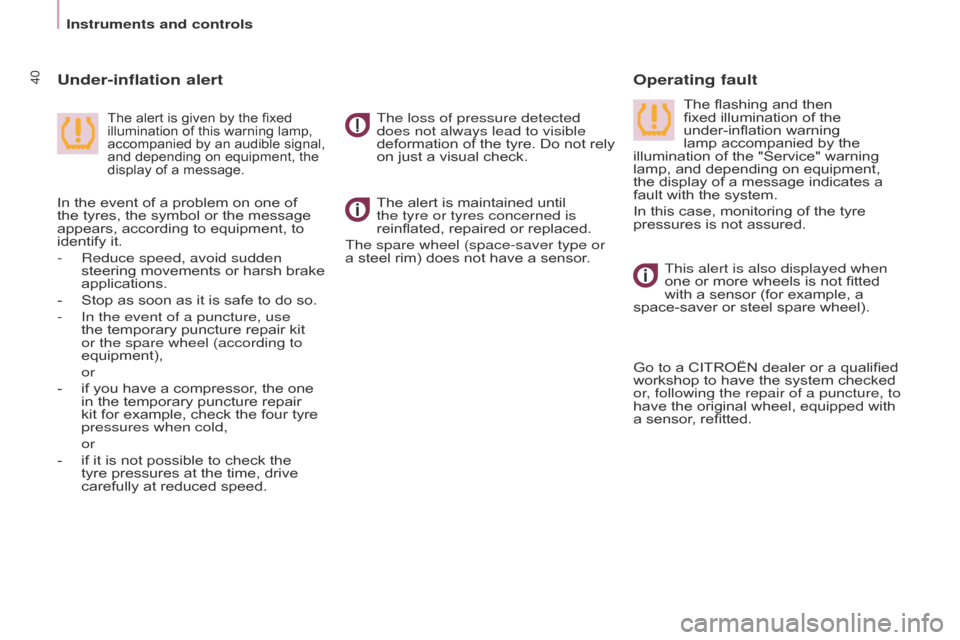
Berlingo_2_VP_en_Chap03_Pret-a-partir_ed02-2014
40
The alert is maintained until the tyre or tyres concerned is
reinflated, repaired or replaced.
The spare wheel (space-saver type or
a
steel rim) does not have a sensor.
Operating faultu
nder-inflation alert
The loss of pressure detected
does not always lead to visible
deformation
of
the
tyre.
Do
not
rely
on
just a visual check.The alert is given by the fixed illumination of this warning lamp,
accompanied
by an audible signal,
and
depending on equipment, the
display
of a message.The flashing and then fixed illumination of the
under-inflation
warning
lamp
accompanied by the
illu
mination of the "Service" warning
lamp,
and depending on equipment,
the
display of a message indicates a
fault
with the system.
In
this
case, monitoring of the tyre
pressures
is not assured.
In
the
event
of
a
problem
on
one
of
the
tyres,
the
symbol
or
the
message
appears,
according
to
equipment,
to
identify
it.
-
Reduce speed, avoid sudden
steering
movements
or
harsh
brake
applications.
-
Stop
as
soon
as
it
is
safe
to
do
so.
-
In the event of a puncture, use
the
temporary
puncture
repair
kit
or the spare wheel (according to
equipment),
or
-
if
you
have
a
compressor,
the
one
in
the
temporary
puncture
repair
kit
for
example,
check
the
four
tyre
pressures when cold,
or
-
if
it
is
not
possible
to
check
the
tyre
pressures
at
the
time,
drive
carefully
at
reduced
speed. This alert is also displayed when
one
or more wheels is not fitted
with
a sensor (for example, a
space-saver
or steel spare wheel).
Go
to
a CITROËN dealer or a qualified
workshop to
have the system checked
or
, following the repair of a puncture, to
have
the original wheel, equipped with
a
sensor, refitted.
Instruments and controls
Page 45 of 276

Berlingo_2_VP_en_Chap03_Pret-a-partir_ed02-2014
43
MAnuAL GEA r BOX
5-speed
6-speed
To change gear easily, always depress
the
clutch
pedal fully.
To
prevent
the
mat from becoming
caught
under
the pedal:
-
ensure
that
the mat is positioned
and
secured correctly on the floor,
-
never
fit
one mat on top of another.
When driving, avoid leaving your hand
on
the
gear
knob as the force exerted,
even
if
slight,
may wear the internal
components
of
the gearbox over time.
changing into 5th or 6th gear
Move the gear lever fully to the right to
engage 5th or 6th gear.
Engaging reverse gear
In the 6-speed configuration, raise the collar under the gear knob to engage
reverse
gear.
never engage reverse gear before
the vehicle is completely stationary .
The
lever should be moved slowly to
reduce the noise on engaging reverse
gear
.
StEErInG WHEEL AdJuStMEnt
When the vehicle is stationary,
release the steering wheel adjustment
mechanism
by pulling the lever.
Adjust
the steering wheel for height
and
reach, then lock the mechanism by
pushing
the lever fully forward.
Gearbox and steering wheel
REadY To Go
3
Page 46 of 276
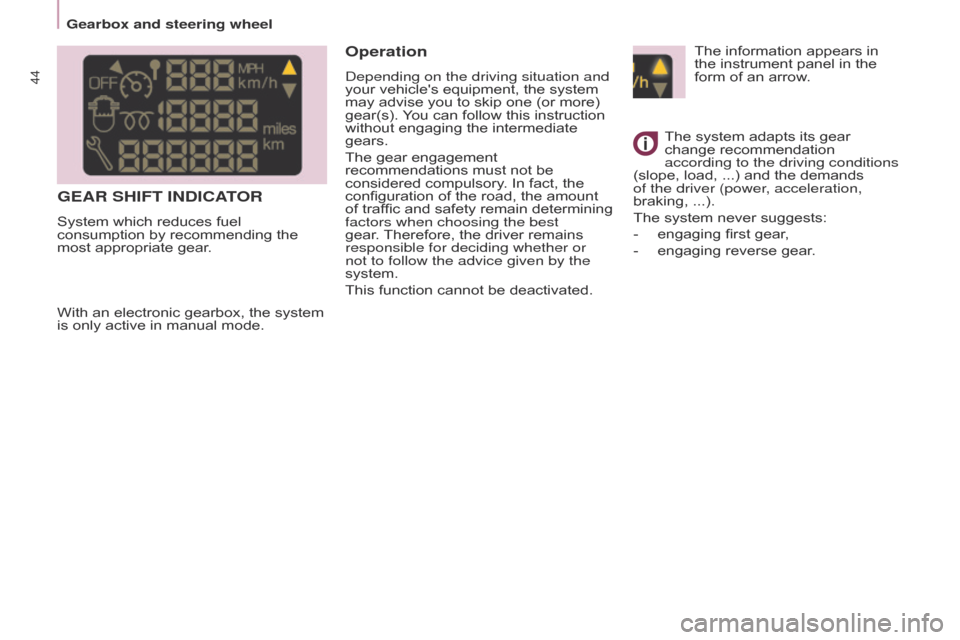
Berlingo_2_VP_en_Chap03_Pret-a-partir_ed02-2014
44
The information appears in the instrument panel in the
form
of an arrow.
The
system adapts its gear
change
recommendation
according to the driving conditions
(slope,
load, ...) and the demands
of the driver (power
, acceleration,
braking, ...).
The
system never suggests:
-
engaging
first gear,
-
engaging
reverse gear.
With
an
electronic
gearbox,
the
system
is
only
active
in
manual
mode.
GEAr SHIFt IndIcAtO r
System which reduces fuel consumption
by recommending the
most
appropriate gear.
Operation
depending on the driving situation and
your vehicle's equipment, the system
may
advise you to skip one (or more)
gear(s).
Y
ou can follow this instruction
without
engaging the intermediate
gears.
The
gear engagement
recommendations
must not be
considered
compulsory. In fact, the
configuration
of the road, the amount
of
traffic and safety remain determining
factors when choosing the best
gear
.
Therefore,
the driver remains
responsible for deciding whether or
not to follow the advice given by the
system.
This
function cannot be deactivated.
Gearbox and steering wheel
Page 47 of 276
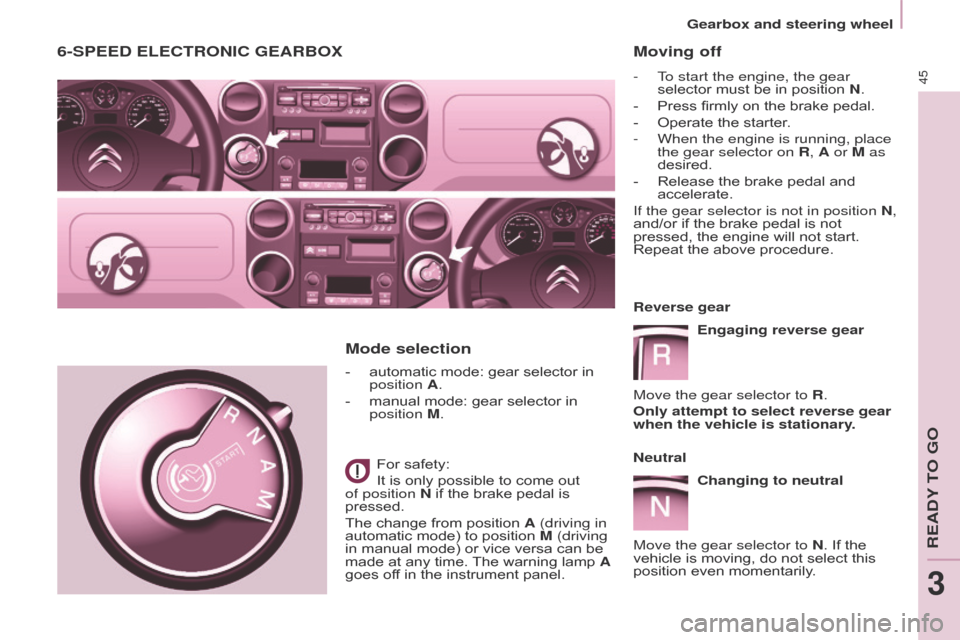
Berlingo_2_VP_en_Chap03_Pret-a-partir_ed02-2014
45
6-SPEEd ELEctrOnIc GEArBOX
- automatic mode: gear selector in position
A.
-
manual
mode: gear selector in
position
M.
For
safety:
It
is only possible to come out
of position
n if the brake pedal is
pressed.
The
change from position A (driving in
automatic
mode) to position M (driving
in
manual mode) or vice versa can be
made
at any time.
The
warning lamp A
goes
off in the instrument panel.
Mode selection Moving off
- To start the engine, the gear
selector must be in position n .
-
Press
firmly on the brake pedal.
-
Operate
the starter.
-
When the engine is running, place
the gear selector on
r , A or M as
desired.
-
Release
the brake pedal and
accelerate.
If the gear selector is not in position
n ,
and/or
if the brake pedal is not
pressed,
the engine will not start.
Repeat
the above procedure.
r
everse gear Engaging reverse gear
Move the gear selector to
r .
Only attempt to select reverse gear
when the vehicle is stationary.
n
eutral
c
hanging to neutral
Move the gear selector to
n . If the
vehicle
is moving, do not select this
position
even momentarily.
Gearbox and steering wheel
REadY To Go
3
Page 48 of 276
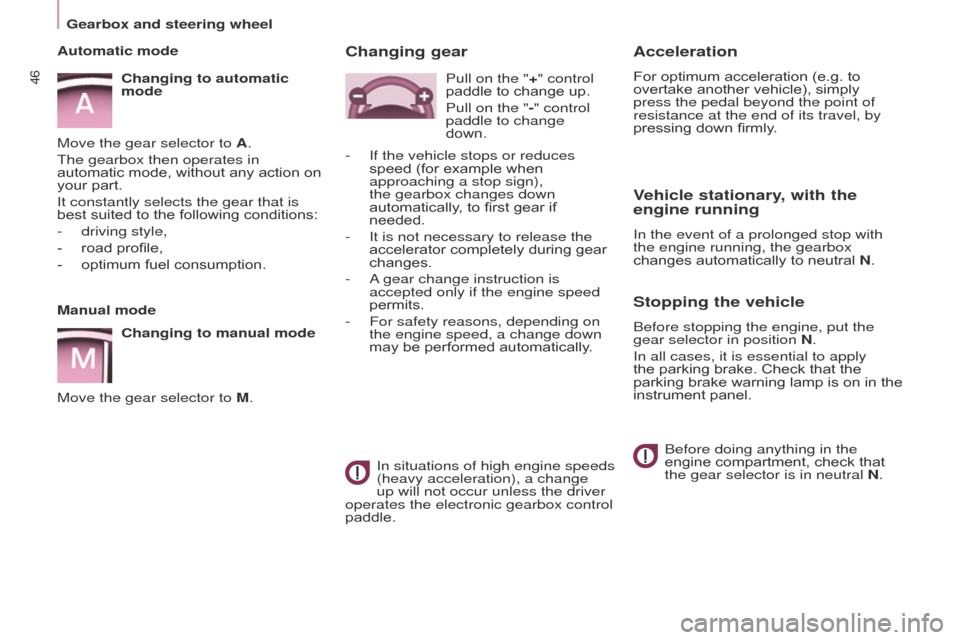
Berlingo_2_VP_en_Chap03_Pret-a-partir_ed02-2014
46
Acceleration
For optimum acceleration (e.g. to overtake another vehicle), simply
press the pedal beyond the point of
resistance at the end of its travel, by
pressing
down firmly.
Vehicle stationary, with the
engine running
In the event of a prolonged stop with
the engine running, the gearbox
changes automatically to neutral n .
Stopping the vehicle
Before stopping the engine, put the
gear selector in position n .
In all cases, it is essential to apply
the
parking brake. Check that the
parking
brake warning lamp is on in the
instrument
panel.
Before doing anything in the
engine
compartment, check that
the gear selector is in neutral
n .
changing gear
In situations of high engine speeds
(heavy acceleration), a change
up will not occur unless the driver
operates the electronic gearbox control
paddle. Pull on the "+" control
paddle
to change up.
Pull on the "-" control
paddle to change
down.
-
If the vehicle stops or reduces
speed
(for example when
approaching a stop sign),
the gearbox changes down
automatically
, to first gear if
needed.
-
It is not necessary to release the
accelerator
completely during gear
changes.
-
a
gear change instruction is
accepted only if the engine speed
permits.
-
For safety reasons, depending on
the engine speed, a change down
may
be performed automatically.
Manual mode
c
hanging to manual mode
Move the gear selector to M. Automatic mode
c
hanging to automatic
mode
Move the gear selector to A.
The gearbox then operates in
automatic
mode,
without
any
action
on
your
part.
It constantly selects the gear that is
best
suited
to
the
following
conditions:
-
driving style,
-
road
profile,
-
optimum
fuel
consumption.
Gearbox and steering wheel
Page 49 of 276
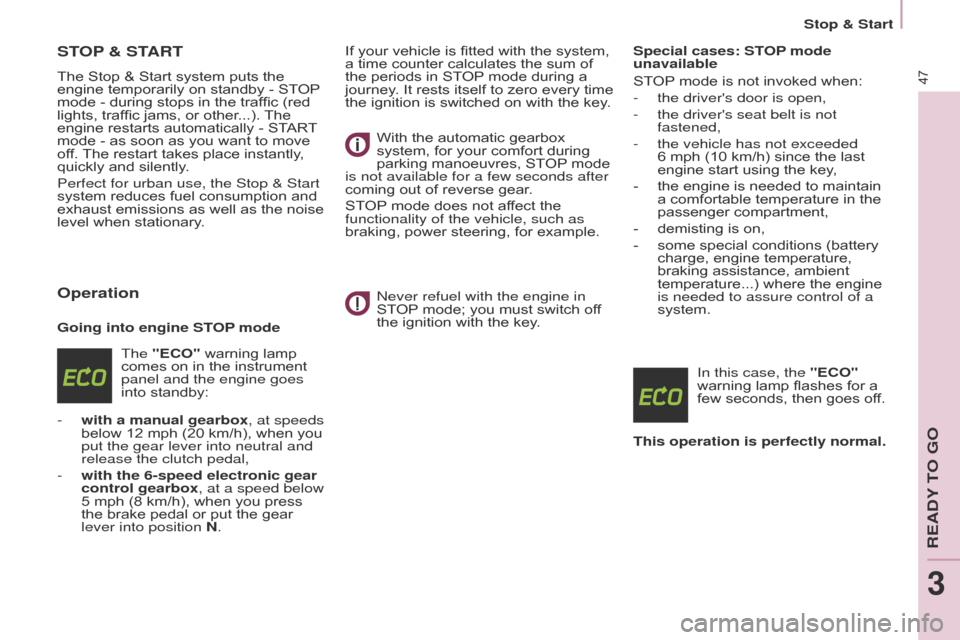
Berlingo_2_VP_en_Chap03_Pret-a-partir_ed02-2014
47
StOP & StArt
The Stop & Start system puts the engine
temporarily on standby - STOP mode
- during stops in the traffic (red
lights,
traffic jams, or other...).
The
engine
restarts automatically - START
mode
- as soon as you want to move
of
f.
The
restart takes place instantly,
quickly
and silently.
Perfect for urban use, the Stop & Start
system
reduces fuel consumption and
exhaust
emissions as well as the noise
level
when stationary.
Operation
Going into engine StOP mode
The "E c O" warning lamp
comes
on in the instrument
panel and the engine goes
into
standby:
-
with a manual gearbox
, at speeds
below
12 mph (20 km/h), when you
put the gear lever into neutral and
release the clutch pedal,
-
with the 6-speed electronic gear
control gearbox
, at a speed below
5
mph (8 km/h), when you press
the
brake pedal or put the gear
lever into position
n .If
your vehicle is fitted with the system,
a
time counter calculates the sum of
the
periods in STOP
mode during a
journey
. It rests itself to zero every time
the
ignition is switched on with the key.
With the automatic gearbox
system,
for your comfort during
parking
manoeuvres, STOP
mode
is not available for a few seconds after
coming
out of reverse gear.
STOP
mode does not affect the
functionality of the vehicle, such as
braking,
power steering, for example.
n
ever refuel with the engine in
STOP
mode; you must switch off the
ignition with the key.Special cases: S t
OP
mode
unavailable
STOP
mode is not invoked when:
-
the driver's door is open,
-
the driver's seat belt is not
fastened,
-
the vehicle has not exceeded
6 mph
(10 km/h) since the last
engine
start using the key,
-
the
engine is needed to maintain
a
comfortable temperature in the
passenger
compartment,
-
demisting
is on,
-
some
special conditions (battery
charge,
engine temperature,
braking
assistance, ambient
temperature...)
where the engine
is needed to assure control of a
system.
In this case, the
"E c O"
warning
lamp flashes for a
few
seconds, then goes off.
t
his operation is perfectly normal.
Stop & Start
REadY To Go
3
Page 52 of 276

Berlingo_2_VP_en_Chap03_Pret-a-partir_ed02-2014
50
Good practice when stopping Good practice when starting
diesel pre-heating warning
lamp
If
the temperature is high
enough,
the warning lamp
comes
on for less than
one
second, you can start
without
waiting.
In cold weather, wait for this warning
lamp
to
go off then operate the starter
(Starting position) until the engine
starts.
d
oor or bonnet open
warning lamp
If this comes on, a door or the bonnet is not closed correctly, check!
Minimise engine and gearbox wear
When switching off the ignition, let the
engine run for a few seconds to allow
the turbocharger (
d iesel engine) to
return
to idle.
d
o not press the accelerator when
switching
off the ignition.
There is no need to engage a gear
after
parking the vehicle.
StArt I n G A nd S tOPPI n G
running and accessories position.
T o unlock the steering, turn the
steering wheel gently while turning the
key
, without forcing. In this position,
certain
accessories can be used.
Starting position.
The starter is operated, the engine
turns
over, release the key.
S
t
OP
position: steering lock.
The
ignition is off.
T
urn the steering
wheel
until the steering locks. Remove
the
key.
Starting and stopping
Page 54 of 276

52
Berlingo_2_VP_en_Chap04_Ergonomie_ed02-2014
dIrEctIOn IndIcAtOr S
"Motorway" function
Press
the control up or down to flash
the corresponding direction indicator
three
times.
LIGHtInG cOntrOL
Left: downwards passing the point of resistance.
r
ight: upwards passing the
point
of resistance.
Front and rear lighting
Lighting off
Automatic
illumination of
headlamps
SidelampsDipped
beam (green)
Main
beam (blue)
d
ipped beam/main beam
change
Pull
the
stalk fully towards you.
Lighting-on audible warning
o
n switching off the ignition, all of the
lamps
turn off, except dipped beam if
automatic
guide-me-home lighting has
been
activated.
To activate the lighting control, turn
ring A to the lighting off position "0"
then
to
the selection of your choice.
o
n opening the driver's door, there is
an audible warning if you have left the
lighting
on.
Checking
by
means
of
the
indicator
lamps
in
the
instrument
panel is described in the
"Instruments
and
controls"
section
of
chapter
3.
direction indicators
Selection is by turning ring A.
Steering mounted controls
Page 55 of 276

53
Berlingo_2_VP_en_Chap04_Ergonomie_ed02-2014
LEd dAYtIME runnInG LAMPS
Rear foglamps (amber, 2nd rotation of the ring forwards).
Front
foglamps (green, 1st
rotation
of the ring forwards).
Front and rear foglamps
Rotate ring B forwards to switch on
and
rearwards to switch off.
The
status
is
confirmed by the warning lamps in
the
instrument panel.
They
operate with the sidelamps and
dipped
beam headlamps. Do not forget to switch them off
when
they are no longer needed.
Operation of the automatic illumination
of
headlamps switches off the rear
foglamps,
but the front foglamps
remain
on.
To switch off the front and rear
foglamps, turn the ring rearwards twice
in
succession.
Automatic illumination of headlamps
In foggy weather or in snow,
the sunshine sensor may detect
sufficient
light.
As
a consequence,
the
lighting will not come on
automatically
.
If
necessary, you must switch
on
the dipped beam headlamps
manually
.
d
o not cover the sunshine sensor
located on the windscreen, behind
the
mirror. It is used for the automatic
illu
mination of headlamps and for the
automatic
rain sensitive wipers.
Activation
Turn the ring to the A
ut
O
position.
The activation of this function is
accompanied
by a message in the
screen.
d
eactivation
Turn
the ring forwards or rearwards.
The deactivation of this function is
accompanied
by a message in the
screen.
The
function is deactivated temporarily
when
you use the manual lighting
control
stalk. The
sidelamps
and
dipped beam
headlamps
switch
on
automatically if
the light is poor
, or
during operation of the windscreen
wipers.
They
switch off as soon as the
light
becomes bright enough or the
windscreen
wipers stop.
This
function is not compatible with the
daytime
running lamps.
o
n starting the vehicle, in daylight the
LED
daytime
running
lamps
come
on
automatically
.
If
the
sidelamps
and
headlamps
are
switched
on
manually
or
automatically,
the
daytime
running
lamps
go
off.
Programming
For countries where exterior lighting by
day is not a legal requirement, you can
activate or deactivate the function via
the
configuration menu.
If the user does not operate any
equipment
for
30
minutes,
the
Economy
mode
engages
to
avoid
discharging
the
battery.
Electrical
functions are put on standby and the
battery
warning
lamp
flashes.
Sidelamp
operation
is
not
affected
by
Economy
mode.
In clear weather or in rain, both day
and
night,
rear
foglamps
dazzle
and
their
use
is
prohibited.
Refer to chapter 8, "Battery
section".
Steering mounted controls
EaSE oF USE and CoMFoRT
4
Page 56 of 276

54
Berlingo_2_VP_en_Chap04_Ergonomie_ed02-2014
If the sunshine sensor
does not function correctly,
the lighting comes on
accompanied
by the service
warning
lamp, an audible
signal
and a message in the screen.
Contact a CITR
o Ë n dealer or a
qualified
workshop.
Guide-me-home lighting
Keeping the dipped beam headlamps on temporarily with the ignition off,
makes
the driver's exit easier when the
light
is poor.
HEAdLAMP BEAM
depending on the load in your vehicle,
the beam setting must be adjusted.
0 -
No
load.
1 -
Partial
load.
2 -
A
verage load.
3 -
Maximum
authorised load.
Manual operation
-
With
the
ignition
off,
"flash"
the
headlamps
within
one
minute
after
switching
off
the
ignition.
The
guide-me-home
lighting
switches
of
f
automatically
after
a
set
time.
Automatic operation
Refer to chapter 10, "Screen
menu
map"
section. Initial setting is position 0.
a
ctivate the function via the
vehicle
configuration
menu. Programming
The
system
is
activated
or
deactivated
in
the
vehicle
configuration
menu.
The
system
is
activated
by
default.
Switching off
The
system
does
not
operate:
-
below a certain angle of rotation of
the steering wheel,
-
above
25
mph
(40
km/h),
-
when
reverse
gear
is
engaged.
Switching on
This
function
starts:
-
when the corresponding direction
indicator is switched on,
or
-
from
a
certain
angle
of
rotation
of
the
steering
wheel.
With
dipped
or
main
beam
headlamps,
this
function
makes
use
of
the
beam
from
a
front
foglamp
to
illuminate
the
inside of a bend, when the vehicle
speed
is
below
25
mph
(approximately
40
km/h)
(urban
driving,
winding
road,
intersections,
parking
manouevres...).
cornering lighting
travelling abroad
If using your vehicle in a country
that drives on the other side of the
road,
the headlamps must be adjusted
to
avoid dazzling on-coming drivers.
Contact a CITR
o Ë n dealer or a
qualified
workshop.
Steering mounted controls